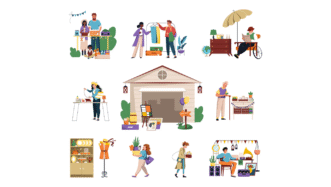LESSON OVERVIEW
This lesson plan is all about telling stories in English. Students learn some vocabulary as well as various time markers which are useful when doing speaking activities. It also includes a short animated video for students to retell. This worksheet might be a great supplement to lesson plans on narrative tenses. You can use our worksheet on narrative tenses.
B2 / Upper Intermediate60 minStandard LessonPremium Plan
VOCABULARY
First, students need to just complete phrases with words from the box. The task includes the following phrases: on purpose, in a hurry, by mistake, all of a sudden, out of nowhere, by accident. Then, they move to another activity. They have to read two short stories which are somehow connected with the provided images. One of the is a love story and the other is a crime story. Their task is to complete a table with adverbs and time markers they find in the texts. Next, they read another story. This time, it is a mystery story, and students have to find mistakes in that text. The mistakes are related to the vocabulary they’ve learnt in the previous tasks.
TELLING STORIES IN ENGLISH
Let’s move to a practical part of the worksheet. First, students have to watch an animated video and retell the story from it. They also get some images to help them retell the story step by step. Finally, the last task is just sheer practice. Students get two sets of various images and they have to build two stories that are connected with the images given. They also have to remember to use vocabulary from the lesson.
WORKSHEETS
Subscribe to unlock these and many other Standalone lesson with the Premium plan
Subscribe














The sentence about Jacob walking “further and further” into the forest needs to be changed. “Further” denotes a metaphorical or figurative distance. “Farther” is used when talking about a physical distance.
Hi Jackie! Thanks for your comment. It seems that they can be used interchangeably in terms of physical distance
https://dictionary.cambridge.org/grammar/british-grammar/farther-farthest-or-further-furthest
Ah, ok, good to know the British English rules. This is not allowed in American English. Thanks for your reply!
It’s quite common in American English too.
https://www.merriam-webster.com/words-at-play/is-it-further-or-farther-usage-how-to-use
A lovely lesson! We did the past simple and past continuous review before doing it and this one blended very well with the grammar topic. However, now my students are really curious about what happened in the stories. Is there any way to find out? =)
That’s great! Thanks for your comment!
That’s our secret :0 But there is potential for students to finish the stories.
BTW we’are preparing a narrative tenses worksheet focused on storytelling
Farther these days is considered a little old fashioned.
Great lesson, thanks, and good opportunity for students to complete the stories. Just to let you know, in the elesson plan, slide 12, the answers also show in the text. Also I think in the text about Keiko, in the second sentence, it should be the past perfect used – ‘He’d had a busy day and had had to cycle….’
Thanks for letting us know about that mix-up in slide 12 – fixed already.
You made a fair point about the tense in the sentence in Keiko’s story. However, I think it’s obvious from the logic of the story so you don’t really have to use PP to show the sequence of events. Do you think the timeline of events is unclear now?
I’ll be using the worksheet next Tuesday. I’ll let you know how it goes 🙂
Hi!! I find it great for B1 level, but how can I use it for B2 students? Any tip? Isn´t it too easy for them?
An easy way out is to skip first tasks and maybe just do the ‘find and fix errors’ task. Let them watch the video and retell the story without any cues. Next, go straight to creating stories. Instead of using the images we provided, you might also use Story Cubes so that each person’s story is unique but still practise using adverbs/time markers. I think this won’t be so easy for B2 students 🙂
Thanks for the great lesson plan!
Don’t these 2 sentences contradict each other? “He had a busy day AHEAD and had to cycle around the city to get everything done. Now, he could finally relax and have his hair done.”
You’re right, Oksana! They do feel illogical and sort of weird in this situation. We got rid of that “ahead” in the first sentence. Thanks for leaving a comment!
Adorable lesson! Looking forward to trying this out.
Thanks and good luck with your classes 🙂
Why isn’t “now” highlighted as a time marker?
Thanks for the comment! We missed that one focusing on other time markers for storytelling. I’ve just updated the worksheets and the e-lesson plan.
Lovely lesson! My students enjoy it quite a lot and I use it for further practice after the lesson plan “Narrative tenses”.
Something I do as an extra activity after ex. 2 is creating an ending for each story using time markers and adverbs. They love it!
Keep up the great work 🙂
Hi there! Thanks for such positive feedback and sharing your idea for extra practice! It sounds cool and definitely makes students speak even more 🙂
Hello and thanks for a fun lesson
My students are Japanese and they found it odd that Keiko is a “he”
Japanese names ending in “ko” are almost always female names
Hi Liza! I’m thrilled you enjoy using this lesson 🙂 Thanks for the comment and for bringing that to our attention. We’ve overlooked that fact, so I’m sorry for that. We’ve just updated the worksheet. I hope it will come in handy in the future as well 🙂